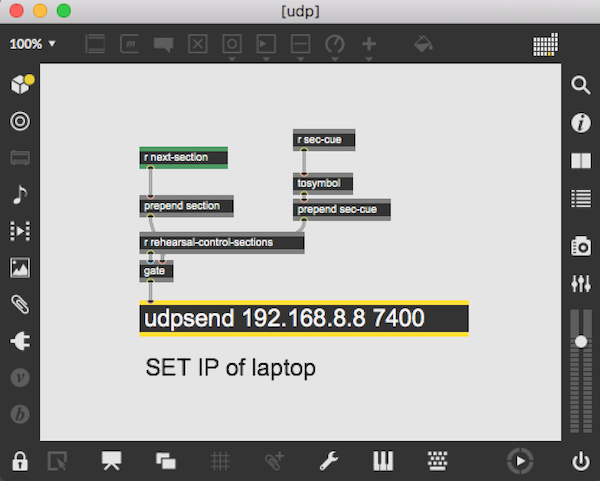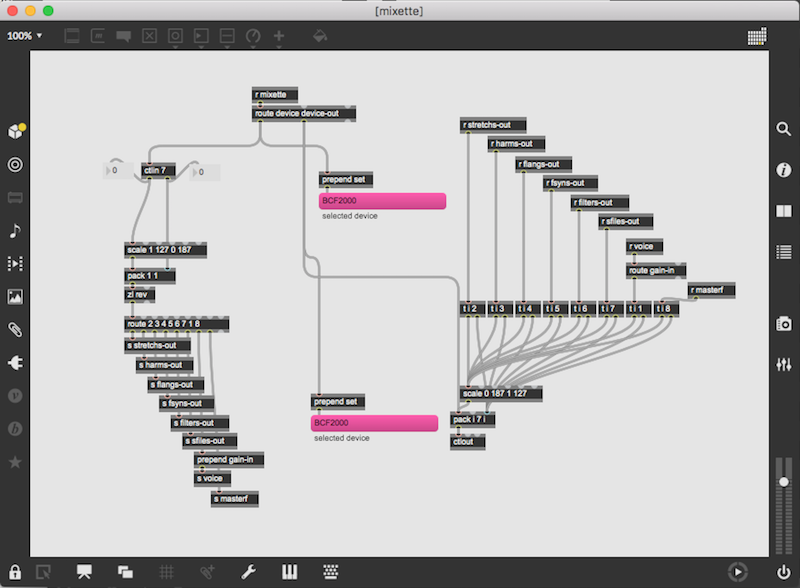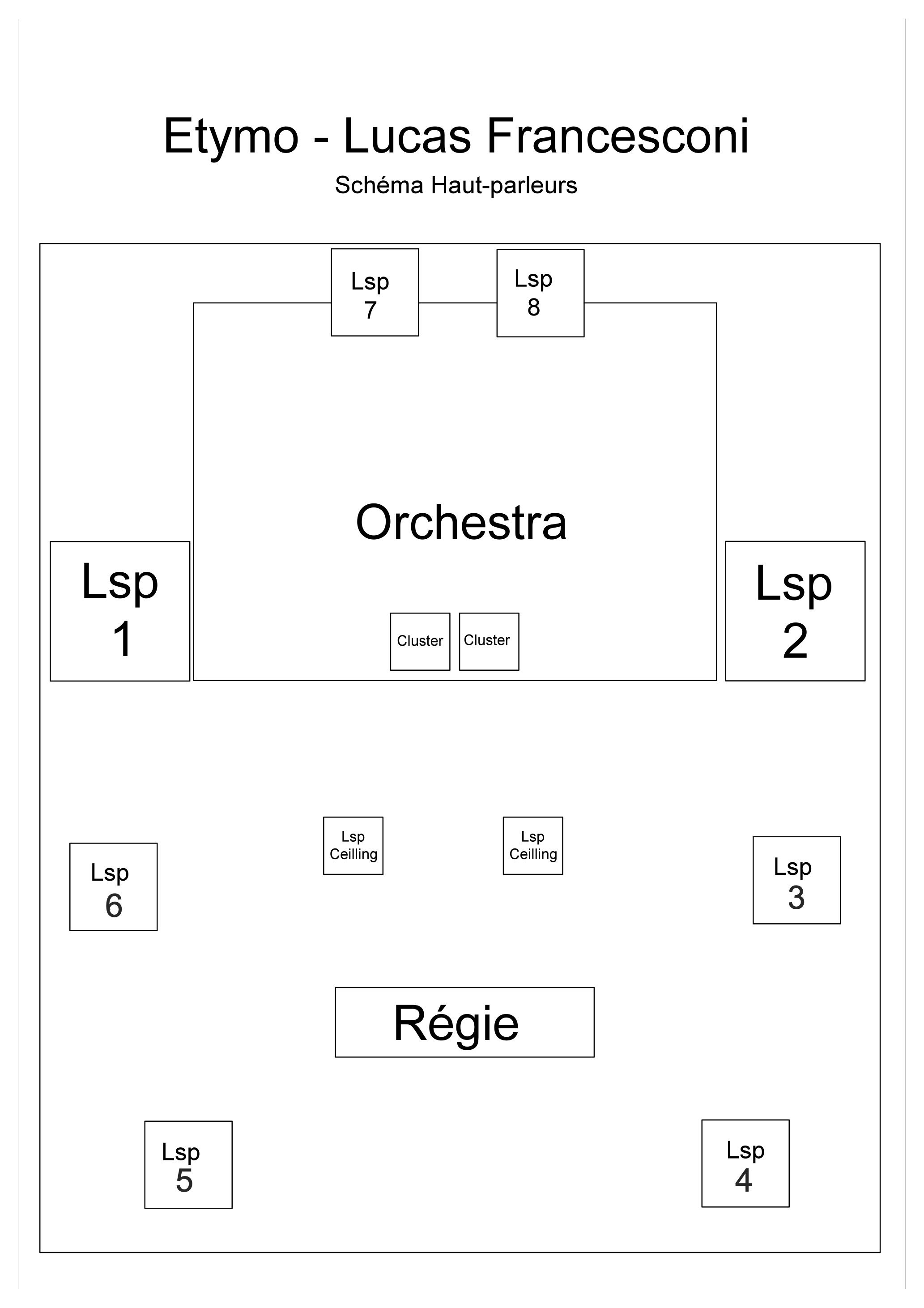Table of contents
- Version documentalist
- Version realisation
- Upgrade Motivation
- Detailed staff
- Electronic equipment list
- Work related information
- Useful links on Brahms
- Instructions
- Description of the piece
- Elements needed to play the piece
- Patch informations
- Folder ‘Etymo-Laptop’
- Details - Details on the keyboard
- SOME MIXING INDICATIONS
- ELECTRONIC SCORE
- Midi Mixer : Midi Controllers
- Keys-Shortcuts on Macintosh keyboard
- NB
- Loudspeaker Setup
- Stage Setup
- Addendum : last performance remarks from Oscar Rodrigues
- Program note
Documentation date: 28 février 2020
Version state
Valid
Validation date: 16 janvier 2022
Version documentalist
- meudic (Benoit.Meudic@ircam.fr)
Version realisation
- Benoit Meudic (Computer Music Designer)
- David Poissonnier (Sound engineer)
Version length
30 mnUpgrade Motivation
Max8 - 48khz - use of samplor instead of sf2
Other version(s)
Detailed staff
- soliste : soprano solo
- flûte (aussi flûte piccolo), hautbois (aussi cor anglais), clarinette, clarinette basse, basson, cor, trompette, trombone, 2 percussionnistes, harpe, piano, clavier électronique/MIDI/synthétiseur, violon, violon II, alto, violoncelle, contrebasse
Channel details
- Number of input channel : 1
- Number of output channel : 9
Electronic equipment list
Computer Music Equipment
-
1 Macintosh Powerbook - Apple Laptops
(Apple)
[CPU clock:1,67] -
1 Mac OS - OS
(Apple)
OS version : osX 10.12.6 -
1 Max 8 - Max
(Cycling74)
Version : 8.1.1 -
1 Hammerfall Digiface - Sound Board
(RME)
1 input (soprano) and 8 outputs + 1 optional output for ceiling -
1 KX 88 - MIDI Keyboard
(Yamaha)
For triggering events and sampler ( 88keys] -
1 BCF 2000 - MIDI Mixer
(Behringer)
for mixing electronics
Audio Equipment
-
4 KM184 - Dynamic Microphones
(Neumann)
-
2 KM140 - Dynamic Microphones
(Neumann)
-
2 KM150 - Dynamic Microphones
(Neumann)
-
2 MK4 - Dynamic Microphones
(Schoeps GmbH)
-
2 Sennheiser 421 - Dynamic Microphones
(Sennheiser)
+ 2 MKH40 -
4 DPA 4061 - Condenser Microphones
(DPA)
+ 2 DPA 4088 -
5 DPA 4021 - Condenser Microphones
(DPA)
-
4 AKG C535 EB - Condenser Microphones
(AKG)
+ 2 Shure KSM 137 -
1 HF System - HF System
(Sennheiser)
-
8 Loudspeaker - Loudspeakers
+ optional 1 for ceiling -
2 subwoofer - Subwoofers
-
1 DM2000 - Digital Mixers
(Yamaha)
-
2 Effect processor - Effects Processor
Two reverbs. One for electronic, one for amplification. [Firmware] [Main function:Reverb]
Work related information
Premiere
- 25 novembre 1994, Paris, Ircam, Espace de projection
Publisher :
- Ricordi
Realisation
- Thomas Hummel
- Tom Mays
Work length
- 23 mn
Useful links on Brahms
- Etymo pour soprano, électronique et ensemble (1994), 23mn
- Luca Francesconi
| File | Author(s) | Comment | |
|---|---|---|---|
| Download [12,0 Mio] | Score Etymo-score | Score with events to trigger | |
| Download [432,9 Mio] | Patch Etymo2020.dmg | Max patch |
Instructions
Description of the piece
“Etymo” (1994) is a piece for ensemble and live electronics. It is divided in three movements. Only voice is treated by electronics in real-time.
Elements needed to play the piece
- 1 computer (1 laptop with MacOS > 10.12.6 core i7 + Max 8.1.1) for electronic treatments and eventually one laptop with max for displaying the events to the keyboard player),
- 1 proximity microphone for the singer + microphones for instruments amplification (4DPA 4061, 2DPA 4088, 5DPA 4021, 4Neumann KM 184, 2Neumann KM 140, 2Neumann KM 150, 2Schoeps MK4, 2Sennheiser MKH 40, 2Senheiser MD421, 2Shure KSM 137, 4* AKG C535)
- 1 mixing console (the electronic requires at least 8 outputs and 1 inputs)
- 8 points diffusion system
- eventually one more loudspeaker placed at the top of the concert hall (for the last event of the piece)
- 1 in / 8 outs audio interface
- 1 keyboard with at least 88 pitches (to trigger the events and play the samples)
- 1 usb midi mixer (for instance bcf2000).
- 1 reverb for electronics
Patch informations
Installation on the main computer (electronic treatments)
Copy the folder ‘Etymo’ on your hard disk.
Launch max, and select the folder ‘Etymo’ in the ‘file preferences’ menu of max.
Open the file ‘Etymo_2020’ in max.
Description
The concert patch is composed of:
- Top left : configuration and initialization interface
- Top right: events trigerring interface
- Bottom: live mixing faders and viewmeters

Initialisation
To initialize the patch:
- load soundfiles + samples for samplor (top left of the patch)
- choose midi devices
eventually configure udp (set the IP of the laptop used for display)


3 - Bang on init
Audio parameters will reset as follows:
dsp sigvs 64, iovs 256, sr 48000, takeover 1, max preempt 1;
4 - Dsp on
You are ready to play the piece.
Folder ‘Etymo-Laptop’
You can use a laptop for keyboard player so that he sees the event trigerring that he controls during rehearsal.
For that connect the laptop with an ethernet cable to the main computer and give the ip adress of the laptop to the main computer (click on ‘eventually configure udp’ at the top of the patch in the initialisation section).
Details - Details on the keyboard
Triggering of events
Only one keyboard is used (see figure 1). It triggers both the samples and the events. High pitches (from 39 (C sharp 2) to 94 (F sharp 7)) trigger the samples. The low pitches (from 21 (A0) to 34 (A sharp 1) of the keyboard trigger the events: each cue correspond to one pitch in a chromatic order: cue 21 (A0), (A sharp 0) etc… If the keyboard makes a mistakes, there are two possibilities: if the pitch is above the last one and below the highest pitch of the section, the computer jumps to this pitch. Otherwise, nothing happens. The changing of section is made with the last event of each section, so if the keyboard forget it, you should trigger it by hand.
Rehearsals
For rehearsal (when mode “enable control sections” =1 in the main patch), sections can be selected with keyboard: keep pressed pitch 107 and then select pitch 60 to 91 for section 36 to 79 (see figure 2 below). Pitch 108 (C8) initializes the patch.
You can use a second laptop for displaying events to the keyboard player. The communication with main computer is made with udp/osc.

Figure 1

Figure 2
Simulation
There is a simulation file (midi + voice recording) that you can use directly from the patch (’simul front’) or from Live (file ‘Etymo-simul-2006’) with some markers on some starting bars. If you use the simulation from max, read the midifile and open the soundfile, then start simul (toggle start/stop). You can only start from the beginning of the piece and cannot stop during simulation so it is preferably to use Ableton Live or another sequencer for more flexibility.
The simulation files are in the folder ’simul’.
SOME MIXING INDICATIONS
- first sfile: as if it was very far
- start the filter quite low
- bar 39 2 raise progressively
- then keyboard plays samplor
- then sfile
- bar 41 1 samplor louder
- bar 51 4 flanger louder
- treatment ‘haro voix’: should not alway appear
- bar 72 hoquetus: mix 100
- bar 73: follow the control of voice in spat
- end of the piece: sfile will play crescendo
- very end: spirale should vanish
ELECTRONIC SCORE
Name of section (bar number) - treatments (bar :
36 sfile - filtre
37 sfile
38 sfile
39 sfile
41 samplor(gliss-multi)
42 flanger - samplor(channel-3) - sfile
46 2 freeze - harmo
47 2freeze
48 freeze - flanger - 2harmo
49 2freeze - flanger - 2harmo
50 2harmo - 2flanger
51 2harmo - 2flanger - 2filtres
52 filter - freeze - sfile
53 harmo
54 harmo(voix)
55 harmo(voix) - 2sfile
57 2freeze(voix)
58 freeze(voix) freeze(cl) freeze(alto)
60 freeze(tr) freeze(cl) freeze(alto) - 2harmo - sfile
61 3freeze(voix) - harmo(voix) - sfile
62 3freeze(voix) - sfile
63 3freeze(voix) freeze(cl) freeze(alto)freeze(tr) filter
64 2freeze(voix)
69 samplor(accs)
70 sfile - filter
71 sfile
72 sfile - samplor(hoquette)
73 samplor(hits-multi) - voice(spat)
76 samplor(passacaille) - voice(spat)
77 sfile
78 sfile - filter(sfile?)
79 freeze(voice) - filter(sfile?) - sfile
Midi Mixer : Midi Controllers

ctlin 7 , midi channels 1 to 7
1 :: gain-in (voice)
2 :: stretchs-out
3 :: harms-out
4 :: flangs-out
5 :: fsyns-out
6 :: filters-out
7 :: sfiles-out
Keys-Shortcuts on Macintosh keyboard
- Space :next event
- -> or <- : go to next/previous event
- ‘return’ stop ALL aiff soundfiles
- p = dac on/off
NB
The folder Etymo/doc contains also several informations about past concerts/technical rider/console patch etc…
Loudspeaker Setup

Stage Setup

Addendum : last performance remarks from Oscar Rodrigues
Dear Serge,I’m so sorry for not replying back about Etymo. It’s been really difficult, we are over-scheduled, lots and lots of things happening.I checked my notes, here they are:
The performance was fine, apart from some cues that were triggered incorrectly by the keyboard (the beginning started before the conductor cued).
I had to do some work balancing things out. For instance, the textural rugged sounds (represented by the curved lines) at the beginning were really low in the mix (I think it was in samplor~, but not 100% sure). They’re there, but we could barely hear them, so I went into the score and changed some of the amp values.
There’s also a problem with the technical rider: the speaker layout is different in your documentation and the patch. Because we had a limited time in the hall for setting everything up, we only found it out during the general rehearsal when we couldn’t hear the circles. We had to route everything according to the scheme in the patch, not the technical rider, which cost us a bit of time.
Another issue is the level and balance of the audio content. Luca was operating and I thought many times of the story you told about putting tape in the BCF faders so that he couldn’t do higher than a given point :) During the concert he was so enthusiastic that it clipped at a point. Because it is digital distortion, it would be best to level everything down and then raise it in the mixing desk, I think… At least it won’t clip in Max.
We were very confused with the click track. Ricordi has it everywhere in the score. And there’s no click track!!! It’s something they could try and fix because Luca told us the click track version isn’t played anymore. I also had the impression that some of the cues are not doing much - they’re only there to be triggering the click track, which doesn’t exist. I might be wrong, though!
Speaking of Ricordi, it would be very nice if they could include the cue numbers in the score and the electronics + voice part. I had to copy them by hand, one by one. Took about 2 hours of work, which could easily be spared next time. It’s time we are not spending working on the patch.
Finally, it’s difficult to find out exactly where to trigger some of the vocal processing cues: some of them we had to anticipate, others to delay. This depends on the rhythm of the voice and it’s a problem we’ll always have, of course. But sometimes, the cues worked better if we triggered them an eighth note before. An example is 52-1.
That’s all. Thank you for your help and your work making this possible. We had lots of fun playing and rehearsing Etymo, it was a pleasure :)
Let me know if you need more information.
Best,
Óscar
© IRCAM

This documentation is licensed under a Creative Commons Attribution-NonCommercial-NoDerivatives 4.0 International License.
Program note
Dites, qu'avez-vous vu ?
Peut-être déjà le titre, cette promesse d'écoute, cette ouverture d'un horizon d'attente : ce n'est pas encore la musique, mais il y a déjà une sorte de pacte – au moins une question : Etymo, qu'est-ce que c'est ? Que vient faire ici la quête d'une origine, d'un sens originel, d'un etymon ? Pourquoi le retour, aussi, de ce (très) vieux problème, celui de savoir si les sons du langage ne sont pas seulement conventionnels, mais également motivés, s'ils ont un lien avec ce qu'ils désignent * ?
Dites, qu'avez-vous vu ?
C'est une phrase de Baudelaire – elle marque une césure dans Le Voyage, des Fleurs du mal ; c'est une phrase que Luca Francesconi aura fait lire à la soprano Luisa Castellani, une phrase qu'il aura analysée dans ses moindres inflexions vocales, ses structures vocaliques et consonantiques, ses durées, ses intonations, ses harmonies (il y a des accords en ces voyelles), ses pauses. Deux mois de travail. Sur une voix, sur la voix : la voix, c'est l'etymon.
Dites, qu'avez-vous vu ?
C'est donc l'origine d'Etymo, c'est cette question qui en génère tout le parcours : proférée puis scrutée avec ces microscopes temporels que sont les outils d'analyse informatique du son, elle révèle ses proportions internes qui, déployées à l'échelle de l'oeuvre, en scandent la forme. Trois parties, avec un interlude entre la première et la deuxième (c'est la virgule de Baudelaire), puis une coda.
Dites.
Premier volet, avant la virgule, avant l'interlude césurant. Un volet où il s'agit de dire : non pas dire quelque chose (un sens signifié), mais simplement dire, mobiliser des particules phonétiques. La musique et la voix sont ici stochastiques, probabilitaires (« arch-aïques », dit aussi Francesconi) ; il n'y a pas de lignes, mais des identités fugitives qui paraissent et disparaissent, dans un apparent désordre ; certains visages changeants, toutefois, laissent des traces qui malgré tout s'accumulent, se superposent, s'empilent. Des bribes d'objets ou de langages, comme dans ce clin d'oeil au jazz (con swing, come uno scat). Dites, c'est un volet phonétique, n'est-ce pas ? Jusqu'à cet apogée, jusqu'à ce point culminant – « le maximum de complexité possible avec ce type d'organisation » – où les objets se superposent dans la polyrythmie.
Virgule.
Après l'explosion du dire, après quelques syllabes fugaces aussi, tirées d'un vers de L'Albatros (« Souvent, pour s'amuser »), c'est l'interlude. Il n'y a que des sons électroniques, dont une voix synthétique : « Le navire glissant sur les gouffres amers. »
Amers. A. Am. Me. Lettres, syllabes de l'aphasie.
M et E, répétés. Cela donne du même : « même dans nos sommeils / La Curiosité nous tourmente et nous roule ». Un volet sémantique, cette fois. Où le sens émerge, peu à peu, dans ou de la voix.
Dites, qu'avez-vous vu ?
Maintenant, la chanteuse peut, elle doit le dire, en une longue cadence, avec des gestes aussi. Pour ouvrir un troisième volet : poétique. Un volet où le chant émerge peu à peu, où la ligne qui se forme pas à pas (du fa au la bémol) génère à son tour, dans l'orchestre, une voix, puis deux, puis plusieurs. Jusqu'au gel, jusqu'à l'accrétion harmonique, jusqu'à la verticalité d'un « épisode spectral ». Le voyage – motif baudelairien s'il en est – est donc aussi, dans Etymo, un « parcours entre les techniques de composition ». Les accords, les « spectres » issus des voyelles de la petite phrase du Voyage alternent entre l'électronique et l'instrumental, selon un véritable dialogue, selon un va-et-vient qui culmine en une sorte de hoquet obstiné. Explosion, point d'orgue : « Et puis, et puis encore ? » On continue, on recommence, puis on s'arrête.
Coda.
Tout cela (Dites-virgule-qu'avez-vous-vu, ou encore, selon ces termes que j'ai empruntés au compositeur : « phonétique », « sémantique » puis « poétique »), tout cela n'est pas un plan à suivre, un « programme », une formule : tout au plus une carte de navigation et une carte qui commence à se replier sur elle-même. Car cette structure tripartite se redouble, en abîme, dans chaque volet : comme le dit si bien Francesconi, il y a des manières phonétiques d'être dans le phonétique, mais il y en a aussi des sémantiques et des poétiques. C'est pourquoi chacune des trois parties a (au moins) trois parties : triple tripartition qui se divise encore, car les frontières ne sont jamais étanches.
Il n'est peut-être pas interdit de tirer un dernier fil, d'avancer une dernière analogie : le point d'interrogation après le chant, après la poésie, c'est celui de cette notation de Baudelaire dans ses Carnets intimes, ici simplement parlée : « Au moral comme au physique, j'ai toujours eu la sensation du gouffre » ?
Dites, qu'avez-vous vu ?
* La question se pose au moins depuis Platon (elle est mise en scène dans le Cratyle, que Francesconi a lu et relu, ainsi que les Six Leçons sur le son et le sens de Roman Jakobson, ou encore les Mimologiques de Gérard Genette) et peut-être a-t-elle été oubliée ou mise entre parenthèses à l'époque du formalisme, celui d'une certaine « avant-garde ». Le compositeur s'est expliqué récemment sur sa position vis-à-vis de cette « avant-garde » dans un texte encore inédit : Les Esprits libres.
Peter Szendy.
Version documentation creation date: 28 février 2020 11:31, update date: 16 janvier 2022 16:43